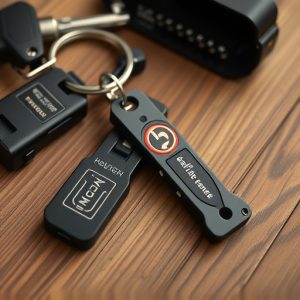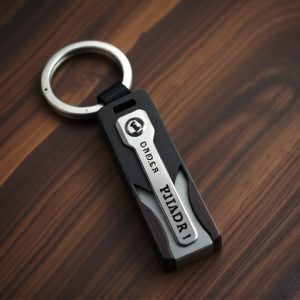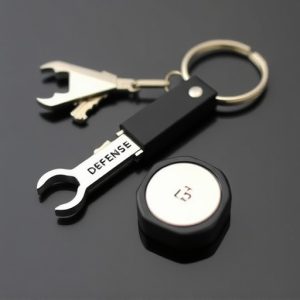Mastering Self Defense Keychains: Legalities, Design, Training
Carrying a self-defense keychain offers discreet personal protection, but understanding and adhering…….
Carrying a self-defense keychain offers discreet personal protection, but understanding and adhering to your state's unique Self Defense Keychain Laws is crucial to avoid legal trouble. These laws dictate what tools are allowed, where they can be carried, and how they can be used. Modern keychains incorporate advanced features like textured surfaces and integrated tools while staying within these legal boundaries, ensuring citizens have reliable self-defense options that comply with local regulations. Choosing durable materials like stainless steel or titanium ensures longevity, and training is essential for effective deployment in critical situations.
In today’s world, self-defense is a crucial consideration for individuals seeking personal safety. One compact solution gaining traction is the tactical self-defense keychain—a versatile tool with a hidden edge. This article explores the legal aspects of self-defense keychains across various states, delving into their evolving designs, key features, and the importance of material choice. We also uncover training methods to ensure effective use in real-world scenarios, providing a comprehensive guide for those interested in this innovative personal safety measure. Understanding your state’s Self Defense Keychain Laws is essential before embracing this handy tactical tool.
- Understanding Self Defense Keychain Legalities: A State-by-State Guide
- The Evolution of Tactical Grip Design for Self Defense Keychains
- Key Features and Benefits of Effective Self Defense Keyring Systems
- Choosing the Right Material for Maximum Durability and Performance
- Training and Technique: Ensuring Optimal Use in Real-World Scenarios
Understanding Self Defense Keychain Legalities: A State-by-State Guide
Carrying a self-defense keychain may offer peace of mind, but it’s crucial to understand the legal implications in your state. Self-defense keychain laws vary significantly across the US, so what’s permitted in one state might not be in another. For instance, some states allow pepper spray and tasers as self-defense tools, while others restrict their use to law enforcement only.
To ensure you’re complying with local laws, conduct thorough research or consult a legal professional. Each state has its own set of rules regarding the types of self-defense devices allowed, permitted carry locations, and use restrictions. Stay informed about Self Defense Keychain Laws by State to make sure your actions align with the law, thus avoiding potential legal issues.
The Evolution of Tactical Grip Design for Self Defense Keychains
The evolution of tactical grip design for self-defense keychains reflects a growing need for personal safety and the diverse preferences of users across different states with varying Self Defense Keychain Laws. Historically, standard keychains were simple metal rings that held keys together, lacking any distinctive features for tactical use. However, as awareness of personal security increased, so did demand for more robust tools. This shift led to the introduction of tactical keychains designed with enhanced grip and functionality in mind.
Modern tactical grip designs incorporate various features like textured surfaces, reinforced metal construction, and integrated tools such as bottle openers or window breakers. These innovations cater to users’ requirements under different Self Defense Keychain Laws by state, ensuring that citizens have access to effective self-defense tools while adhering to local regulations.
Key Features and Benefits of Effective Self Defense Keyring Systems
Effective self-defense keyring systems, often overlooked as tactical tools, offer a range of features designed to enhance personal safety. One of the key benefits is their discreet nature; these keychains can fit comfortably on a keychain, allowing users to carry them anywhere without drawing attention. This subtle design belies their potential life-saving capabilities. Moreover, they are equipped with specialized grip mechanisms that provide a secure and comfortable hold during critical situations, enabling users to deploy them swiftly and efficiently.
Beyond individual protection, understanding self-defense keychain laws by state is crucial. Different jurisdictions have varying regulations regarding the legality and restrictions on carrying self-defense tools like keychains. Staying informed about these laws ensures responsible ownership and minimizes legal repercussions. With proper knowledge, individuals can ensure their self-defense keychain systems remain a reliable resource for personal safety without violating any local statutes.
Choosing the Right Material for Maximum Durability and Performance
When crafting a self-defense keyring tactical grip design, selecting the optimal material is paramount for both durability and performance. The right material ensures your keychain can withstand regular use and remain reliable in critical situations. High-quality metals like stainless steel and titanium are popular choices due to their exceptional strength-to-weight ratio and resistance to corrosion. These materials are particularly advantageous when navigating challenging environments or adhering to self-defense keychain laws by state, which often require robust, durable tools.
Considered industry standards for tactical gear, these metals offer superior grip and durability, enhancing your control during use. Moreover, their resilience against wear and tear ensures the keychain maintains its functionality over time, making it a dependable companion in various situations, including those governed by self-defense keychain laws by state.
Training and Technique: Ensuring Optimal Use in Real-World Scenarios
Training and technique play a pivotal role in ensuring optimal use of a self-defense keyring tactical grip design in real-world scenarios. Beyond just carrying a handy tool, users must familiarize themselves with effective handling and application methods. Regular practice sessions can help individuals develop muscle memory for rapid deployment and precise strikes, crucial aspects when seconds count.
Understanding local Self Defense Keychain Laws by State is also essential before employing such a device. Legality varies widely, and knowing your rights and responsibilities can prevent unintended consequences. Training should include not only practical exercises but also awareness of these legal parameters to ensure responsible use in self-defense situations.
In conclusion, a well-designed self defense keychain equipped with a tactical grip can be a valuable tool for personal safety. Understanding the legalities of carrying such devices varies state-by-state, as our guide highlights. The evolution of tactical grip design focuses on enhancing durability and usability, ensuring effective performance in real-world scenarios. Key features like sharp edges, durable materials, and ergonomic grips significantly contribute to their functionality. When choosing a self defense keychain, consider both its legal standing and practical benefits, backed by proper training and technique for optimal use.


